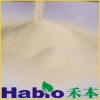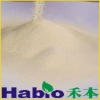1 cleaves internal beta-1, 4-glycosidic bonds of mannan 2 increase energy utilization
Anti-nutrient Effect of Mannan
Mannan, the most widely distributed hemicellulose in plant feed materials, is a kind of non-starch polysaccharide (NSP). It can be commonly found in plant feed, with high level in feed meals, particularly in soybean meals (Table 1).Even in some non-conventional cake meals, such as palm meals and coconut meals, higher contents of mannan have been determined (about 25% ~ 35%).
Table1 Contents of Mannan in conventional feed stuff
Feed stuff | Total mannan(%) | Feed stuff | Total mannan (%) |
Soybean meal(44%) | 1.5~1.8 | Dehulled soybean meal(44%) | 1.1~1.3 |
Palm meal | 2.5~3.0 | Rapeseed meal | 0.48 |
Coconut meal | 25~35 | Cottonseed Meal | 0.37 |
Sunflower meal | 0.56 | Peanut Meal | 0.52 |
Sorghum | 0.10 | Wheat | 0.11 |
Rice bran | 0.33 | Sesame meal | 3~4 |
1. Interacting with intestinal lipid micelles and polysaccharide-protein complexes, thus reducing the absorption of nutrients.
2. Combining with digestive enzymes, bile salts, thus reducing the activity of digestive enzymes and affecting the digestion and absorption of fat, which result in the decrease of feed energy value.
3. Nutrients are enwrapped by mannan and hard to be digested. the chyme viscosity increases, thus destroying the intestinal micro-ecological balance and affecting the health of livestock and poultry.
4. Through interfering the insulin secretion and the generation of insulin-like growth factors, the absorption rate of dextrose in intestinal and the process of carbohydrate metabolism are degraded, thus reducing the energy value of feed.
Product Features
1. High mannan specificity, especially effective in degrading mannan of feed meals, such as soybean meal.
2. leading-edge technology of genetic engineering strain, advanced submerged fermentation and post-treatment process are used to enhance the effect.
3. Broad pH range of activity (4-7.5) ensures the ideal effect of enzyme in animal digestive tract.
4. Significant effect. The decrease of feed cost and the increase of energy utilization have been proved by practices after using β-mannanase in feed.
Product Functions
β-Mannanase, as a kind of hemicellulose, cleaves internal β-1, 4-glycosidic bonds of mannan. The non-reducing terminal of degradation products is mannose. The specific roles are as follows:
1. Reducing the chyme viscosity and increasing the digestion and absorption of nutrients through decomposition of mannan. NSP.
2. Degrading the complex of mannan and lipopolysaccharide and protein to enhance the absorption of fat and increase the energy value of feed stuff.
3. Eliminating the combination of mannan, NSP, digestive enzyme and bile salt, thus improving the digestion enzyme activity.
4. Degrading mannan, breaking down cell wall and releasing enwrapped nutrients to contact with digestive enzymes, thus enhancing the nutritional value of feed.
5. Mannose, the degradation product of mannan, can reduce the colonization of pathogenic bacteria in intestine, protect the integrity of intestinal mucosa, significantly promote the proliferation of profitable bacteria represented by bifidobacterium in animal intestine, lessen the diarrhea, and ultimately improve the production performance of animal.
Specifications and Usage
Specifications | Enzyme activity(U/g) | instructions |
powder | 300, 1000 | It can be used solo by adding 50g/T (1000U/g β-mannanase) into compound feed. Using with other enzymes, the effect will be more pronounced. |
granule | 300, 1000 |
sell feed additive beta-mannanase












